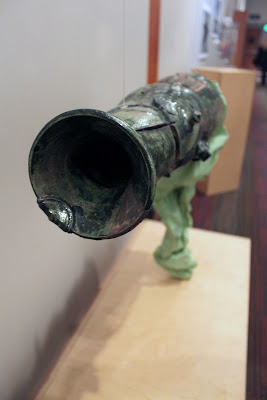
In addition, the show allows me to tip that hat to some "art heroes" who I've admired but never met: Rob Epstein and Jeffrey Friedman, whose documentary The Times of Harvey Milk is an exemplar of socially committed historiography, and of course Allen Ginsberg himself.
And while there are no paintings or even doodles by James Franco featured in the show, I'd like to think it offers at least a small extension of his project to establish all reality as an emanata of the all-encompassing Francoverse.
I'll have a small bit of my own work in the show (for past posts on my involvement with Howl, click here) -- what follows is the official press release:

The Art of Howl at the Cartoon Art Museum
655 Mission St. San Francisco, CA 94105
May 14 – September 11
Opening Reception Thursday, May 19, 7:00-9:00pm
Rob Epstein and Jeffrey Friedman's film, Howl, produced by Werc Werk Works, opened the 2010 Sundance Film Festival. Featuring James Franco as the beat poet Allen Ginsberg, the film took an experimental approach to documenting the creation and performance of Ginsberg's revolutionary poem, "Howl"– as well as the obscenity trial that followed when, after undercover policemen purchased copies of Howl and Other Poems from City Lights Bookstore, the state tried to suppress its publication. The film blends glimpses of Ginsberg's personal life, recreations of the obscenity trial, and animated sequences that accompany Franco's performance of the poem, riffing on its ideas and images.

The Art of Howl gives a revealing look behind the scenes at the creative process of turning poetry into animation. The film directors enlisted Eric Drooker to design the animation; Drooker, a graphic novelist and painter, was friends with Ginsberg and had collaborated with him on the book Illuminated Poems. John Hays, a San Francisco-based animation veteran, directed the sequences, which were animated by The Monk Studios in Thailand.

Translating Ginsberg's incendiary, oracular, stream-of-consciousness language into moving images was a unique challenge. The animation, like the poem, conjures a world of outcasts, "deviants," outlaws, poets and prophets digging for scraps of connection and enlightenment under the shadow of "Moloch" – the overpowering industrial cityscape that demands submission, conformity, and ultimately annihilation.

This multimedia exhibit includes character design drawings, animation keyframes and concept art, photos by Allen Ginsberg, storyboards, animatics, and images from Drooker's graphic novel version of the poem. The Cartoon Art Museum is pleased to present this animated interpretation of a piece of literary history – just a couple miles from City Lights Bookstore, the launching-pad for Ginsberg's poetic career, and through their victory at the Howl trial, a historic ground zero for freedom of expression.
Curated by Andrew Farago, Eric Drooker and Chris Lanier

Telling Pictures: Rob Epstein and Jeffrey Friedman
Rob Epstein and Jeffrey Friedman have been making non-fiction and feature films together since 1987 when they founded Telling Pictures, a San Francisco production company. Their films have played in movie theaters, at festivals, and on television throughout the world. Between them they have received two Academy Awards, five Emmy Awards, three Peabodys, as well as Guggenheim and Rockefeller Fellowships. Their films together include Common Threads: Stories from the Quilt (Academy Award, Feature Documentary, 1989), Where Are We? (Sundance Documentary Competition, 1991), The Celluloid Closet (Emmy Award for directing, Peabody, duPont-Columbia Awards, 1995), and Paragraph 175 (Sundance Film Festival jury award for directing, 2000). Their website is www.tellingpictures.com.

Werc Werk Works
Werc Werk Works is an independent film production and finance company dedicated to the production and financing of high caliber, story-driven films with wide appeal. Recently released films include Howl starring James Franco, and the multiple Spirit Award nominated Life During Wartime. Upcoming releases include The Convincer and the new Lawrence Kasdan film Darling Companion. Werc Werk Works is also co-producer of the Béla Tarr film The Turin Horse that was recently awarded the Silver Bear at the Berlin Film Festival. Their website is www.wercwerkworks.com.

The Monk Studios
The Monk Studios is a boutique Visual Effects and Animation Studio, located in Thailand. The philosophy of the company is to focus on producing world-class imagery using highly skilled artists and cutting edge technology. The company produces high quality Visual Effects (VFX) and Animation for both feature films and commercials in the Asian and Western markets.
Eric Drooker
Eric Drooker is a painter and graphic novelist, born and raised on Manhattan Island. He's the award-winning author of Flood! A Novel in Pictures, and Blood Song. His paintings appear on covers of The New Yorker, and hang in numerous collections. His website is www.Drooker.com.
John Hays
John Hays is an award-winning animation producer and director, having worked at ILM, Colossal Pictures, Lucasfilm, and co-founded W!LDBRAIN Studios. His projects range from Howl to Yo Gabba Gabba, and a recently completed animated dream sequence in Lawrence Kasdan’s new film Darling Companion.

















































